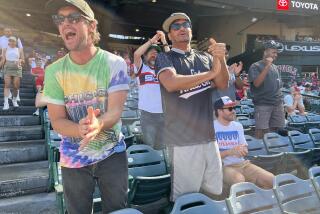The Last At-Bat for Chicago’s Comiskey Park
- Share via
CHICAGO — It’s the last turn at bat for old Comiskey Park.
After 80 years, the senior ballpark in the majors is closing for good at the end of this season.
“I think the season will be special,” said Manager Jeff Torborg, whose Chicago White Sox move across 35th Street to a brand new, $150 million Comiskey Park for opening day 1991.
The place called home by such stars as “Shoeless” Joe Jackson, Minnie Minoso, Luke Appling, Harold Baines and Carlton Fisk is targeted for the wrecker’s ball to make room for a parking lot or shopping center.
Comiskey’s last season kicks off Monday with the Sox scheduled to play host to the Milwaukee Brewers. Chicago shortstop Ozzie Guillen says he will miss the old park, but it’s time to move on.
“It’s my first big-league ballpark. You’re never going to forget your first big-league ballpark. I really like it, but it’s time to get a new one,’ he said.
When opened on July 1, 1910, it was billed the “Baseball Palace of the World.”
Built for and named after White Sox founder Charles Comiskey, the park had upper decks from first to third base, with two detached grandstands in right and left. It cost $1 million to construct and it seated 30,000.
Baseball had never seen anything like it before. It was only the third concrete and steel stadium built in the United States.
A downtown parade and gala South Side celebrations marked the opener, which the home team lost 2-0 to the St. Louis Browns before a packed house.
Over the past 80 years, the park would see the good, the bad, the ugly and the worst scandal in sports history.
Comiskey, who had changed the name of his franchise from the White Stockings, moved the team from a 7,500-seat, wooden park at 39th and Wentworth, and built the Sox into a formidable club.
They beat the New York Giants in the 1917 World Series, their last world crown.
After Chicago lost the 1919 Series to the Cincinnati Reds, baseball was rocked by Black Sox Scandal. Eight Sox players were banned from the game for life for their part in a gamblers’ conspiracy to fix the Series.
It was at Comiskey Park where a small boy came up to Jackson and said, “It ain’t true, Joe” according to the recent book on the scandal, “Eight Men Out,” by Eliot Asinof.
Many would prefer to remember the kid insisting, “Say, it ain’t so, Joe?”
It would be 1959 before the White Sox got into another Series. This time the “Go, Go” Sox of Minoso and Nellie Fox went, and lost to the Dodgers.
In 1933, Comiskey Park was the site of the first All-Star Game, which returned to the South Side stadium on the event’s 50th anniversary.
Night games started there in 1939, almost half a century before the North Side Cubs got lights for Wrigley Field.
The American League color barrier was broken at Comiskey when black outfielder Larry Doby of the Cleveland Indians came to bat as a pinch-hitter on July 5, 1947.
In 1960, colorful Sox owner Bill Veeck had built beyond the center-field bleachers the world’s first “exploding scoreboard,” with a display of smoke and rockets after each Sox homer.
Veeck also was king of the promotion and give-away. Comiskey Park fans have received bats, jerseys, tiny clocks, Bermuda shorts, sunglasses and S&H; savings stamps. They’ve sat through donkey baseball, cow milking and beer case stacking contests.
In 1969 Veeck was gone and the stadium’s name was changed to White Sox Park. The American League’s first artificial surface was installed.
But Veeck was back in 1976, rescuing the franchise from a move to Seattle, and he returned grass and the name, Comiskey, to the park.
In 1979, Chicago radio personality Steve Dahl staged a Disco Demolition Night between games of a doubleheader. Rioting anti-disco fans did so much damage that the Sox had to forfeit the second game.
It was yet another world’s first for the ballpark.
The club won the AL West in 1983. But by the end of the decade, the team had fallen on hard times and so had the ballpark. The owners threatened to move the White Sox to Florida unless a publicly owned stadium was built for the team.
In 1988, the melodrama over Illinois possibly losing the lucrative franchise lasted months until fans protested and Gov. James R. Thompson intervened. He lent his support to state legislation that resulted in the new 43,000-seat, open-air Comiskey Park.
The old park, with seating for 43,951 this season, also was home to the Chicago Cardinals football team off and on from 1922 until 1958, but it gained its fame as the longtime home of the White Sox.
The players still argue over whether Comiskey favored hitters or pitchers, but utilityman Steve Lyons insists there’s really no argument.
“The grass is slow, the winds is blowing in all the time, and you have to hit it a ton to get it out of there,” said Lyons, who batted .217 at home and .305 on the road last season. “It’s a pitcher’s ballpark and I’m not a pitcher.”
More to Read
Go beyond the scoreboard
Get the latest on L.A.'s teams in the daily Sports Report newsletter.
You may occasionally receive promotional content from the Los Angeles Times.










